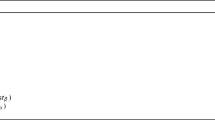Abstract
We investigate how a customer (an enterprise or a large organization), when facing a percentile-based pricing policy, can optimally balance the Internet access cost and the traffic buffering delay penalty by traffic regulation. The problem is referred to as the Optimal Traffic Regulation (OTR) problem. Solutions to various cases of the OTR problem are provided. For a customer with a single-homed ISP, we present optimal solutions to the OTR problem based on dynamic programming for the offline case with a known traffic demand pattern. A real-time traffic scheduling algorithm is proposed to deal with the online case where the traffic demands are different from a given demand pattern. We further extend the dynamic programming model to the case of dual-homed ISPs. Experimental results on the data from an Internet trace confirm the effectiveness of our solutions.
Similar content being viewed by others
References
Antoniadis P, Courcoubetis C, Mason R (2004) Comparing economic incentives in peer-to-peer networks. Comput Netw 46:133–146
Cao X-R, Shen H-X, Milito R, Wirth P (2002) Internet pricing with a game theoretical approach: concepts and examples. IEEE/ACM Trans Netw 10:208–216
Chang C-S (1998) On deterministic traffic regulation and service guarantees: a systematic approach by filtering. IEEE Trans Inf Theory 44:1097–1110
Chang C-S, Cruz RL, Le Boudec J-Y, Thiran P (2002) A min, + system theory for constraint traffic regulation and dynamic service guarantees. IEEE/ACM Trans Netw 10(6):805–817
Cisco (2006) Configuring quality of service for voice. Available at: http://www.cisco.com/univercd/cc/td/doc/product/software/ios122/122cgcr/fvvfax_c/vvfqos.htm
Cerruti S, Wright C (2002) ISP bandwidth billing—how to make more or pay less. Rating matters, vol 13. Available at: http://www.servicelevel.net/rating_matters/matterslist.htm
CFDynamics (2007) available at: http://www.cfdynamics.com/cfdynamics/dedicated/dedicatedhostingbasic.cfm
Courcoubetis C, Weber R (2003) Pricing communication networks: economics, technology and modelling. Wiley, New York
Fukuda K, Amaral LAN, Stanley HE (2003) Dynamics of temporal correlation in daily Internet traffic. In: Proceedings of the GLOBECOM, pp 4069–4073
Fulp EW, Reeves DS (2004) Bandwidth provisioning and pricing for the networks with multiple classes of service. Comput Netw 46:41–52
Goldenberg DK, Qiu L, Xie H, Yang YR, Zhang Y (2004) Optimizing cost and performance for multihoming. In: Proceedings of the SIGCOMM, pp 79–92
Keon NJ, Anandalingam G (2003) Optimal pricing for multiple services in telecommunications networks offering quality-of-service guarantees. IEEE/ACM Trans Netw 11:66–80
Li T, Iraqi Y, Boutaba R (2004) Pricing and admission control for QoS-enabled Internet. Comput Netw 46:87–110
Ma M, Hamdi M (2000) Providing deterministic quality-of-service guarantees on WDM optical networks. IEEE J Sel Areas Commun 18:2072–2083
Net1plus.com (1995) available at: http://www.net1plus.com
NLANR (2005) NLANR PMA, special traces archive. Available at: http://pma.nlanr.net/Special/
Odlyzko AM (2004) The evolution of price discrimination in transportation and its implications for the Internet. Rev Netw Econ 3:323–346
Ros D, Tuffin B (2004) A mathematical model of the Paris metro pricing scheme for charging packet networks. Comput Netw 46:73–85
Salehi JD, Zhang S-L, Kurose J, Towsley D (1998) Supporting stored video: reducing rate variability and end-to-end resource requirements through optimal smoothing. IEEE/ACM Trans Netw 6(4):397–410
Service Level Corporation (2002) http://www.servicelevel.net/rating_matters/matterslist.htm
Shakkottai S, Srikant R (2005) Economics of network pricing with multiple ISPs. In: Proceedings of the INFOCOM, pp 184–194
The Internet NG Project (2002) available at: http://ing.ctit.utwente.nl/
Wang H, Xie H, Qiu L, Silberschatz A, Yang YR (2005) Optimal ISP subscription for Internet multihoming: algorithm design and implication analysis. In: Proceedings of the INFOCOM, pp 2360–2371
Wang X, Schulzrinne H (2000) An integrated resource negotiation, pricing, and QoS adaptation framework for multimedia applications. IEEE J Sel Areas Commun 18:2514–2529
Yaiche H, Mazumdar RR, Rosenberg C (2000) A game theoretic framework for bandwidth allocation and pricing in broadband networks. IEEE/ACM Trans Netw 8:667–678
Author information
Authors and Affiliations
Corresponding author
Additional information
Part of the results has been presented in the First International Conference on Scalable Information Systems.
Rights and permissions
About this article
Cite this article
Wang, J., Chen, J., Yang, M. et al. Traffic regulation with single- and dual-homed ISPs under a percentile-based pricing policy. J Comb Optim 17, 247–273 (2009). https://doi.org/10.1007/s10878-007-9111-3
Published:
Issue Date:
DOI: https://doi.org/10.1007/s10878-007-9111-3




